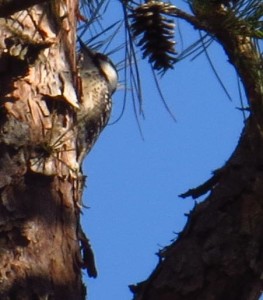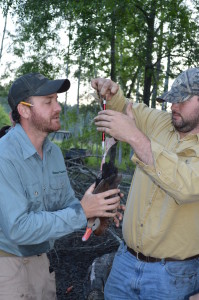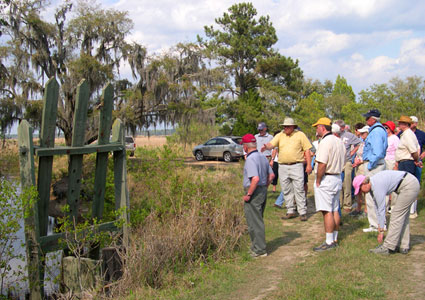The Nemours Wildlife Foundation is regularly engaged in short and long term studies focusing on conservation, management, and sustainability of wildlife populations and their habitats. Dr. Ernie Wiggers, president and CEO of the Foundation, currently holds adjunct faculty positions in the Department of Forestry and Natural Resources at Clemson University, and the School of Forestry and Natural Resources at the University of Georgia. An adjunct position at Marshall University is also in the works.
Staff Biologist, Beau Bauer, in addition to supervising interns and participating in other research, is working on his own Master’s Thesis.
Although the Foundation has access to its own lands which can be used as an outdoor laboratory, its research program is not necessarily confined to this site. The Foundation will pursue research opportunities wherever it believes its resources and staff can make a difference.
Current Projects:
- American Alligator Ecology in Human Dominated Landscapes of Coastal South Carolina. Dr. Cathy Bodinof Jachowski and Anje Kidd, PhD Graduate Student, Clemson University. Funding Partners: Nemours Wildlife Foundation, Fripp Island Resort, Kiawah Island, Sea Pines Resort, LLC, Community Services Associates, Inc. & The Salty Dog, Inc., South Carolina Department of Natural Resources, Spring Island Trust.
- Community Dynamics and Interactions of Mammalian Predators Within the Impoundment Systems of Coastal South Carolina. Amanda Williams, Graduate Student, Dr. David Jachowski, Advisor, Clemson University. Funding Partner: Nemours Wildlife Foundation.
- Regional Examination of the Contribution of Nest Boxes to Wood Duck Recruitment in the Southeast and Mid-Atlantic United States; Ernie P. Wiggers and Beau Bauer, Nemours Wildlife Foundation and Richard M. Kaminski, James C. Kennedy Waterfowl & Wetlands Conservation Center. A pilot study on the Santee Wildlife Refuge near Summerton, SC will start in January 2019. We expect to have study sites in multiple states from Virginia to Mississippi in 2020. The recruitment of females into a population is critical to sustainability and growth. Female recruitment rates from nest boxes have not been well studied and this will be the first multi-state effort to address this question.
Recently Completed Projects:
- Effects of Hydrological Management for Submersed Aquatic Vegetation Biomass and Invertebrate Biomass and Diversity in South Carolina Coastal Impoundments. Beau A. Bauer, M. S. Thesis, Dr. Drew Lanham, Advisor. Clemson University. Funding Partners: James C. Kennedy Waterfowl & Wetlands Conservation Center, Nemours Wildlife Foundation. 2018.

Rare and endangered Red Cockaded Woodpeckers have been released at Nemours Plantation and are monitored by Nemours biologists and U.S. Fish & Wildlife Service.
Abstract: Widgeongrass (Ruppia maritima) is a cosmopolitan submersed aquatic vegetation (SAV) of brackish wetlands. Management of SAV species is practiced in impounded tidal wetlands in coastal South Carolina to provide forage for waterfowl and other water birds. Widgeongrass also provides habitat and associated periphyton for aquatic invertebrates. I conducted an experiment to test effects of complete drawdown (CD) to dried substrate versus partial, shallow water (0–10 cm) drawdown (PD) during May–June 2016 on aquatic invertebrate and SAV biomasses and aquatic invertebrate diversity in managed brackish tidal impoundments (MTI) in the Ashepoo, Combahee, and Edisto Rivers Basin, South Carolina, because such data were lacking to inform managers of best practices to promote standing crops of invertebrates and SAV. I sampled sediments and SAV in 20 MTIs (8 complete and 12 partial drawdown MTIs) and three natural tidal marsh sites (control) during August 2016, November 2016, January 2017, and April 2017. I used mixed model analysis of variance to test ( α = 0.10) effects of drawdown on SAV and benthic invertebrate biomasses (g[dry]/m2) and benthic invertebrate diversity (Shannon H′). I used mixed model analysis of covariance to test ( α = 0.10) effects of drawdowns and SAV biomass (covariate) on total invertebrate biomass (benthic and epifaunal combined; g[dry]/m2) and diversity (Shannon H′). I detected a drawdown effect on SAV (P = 0.014) and benthic (P = 0.063) and total (P = 0.014) invertebrate biomasses for August 2016, benthic and total invertebrate biomasses for November 2016 (P = 0.022 and P = 0.041, respectively) and April 2017 (P = 0.042 and P = 0.030, respectively), and benthic invertebrate biomass for January 2017 (P = 0.079). I also detected a drawdown effect on benthic invertebrate diversity for August 2016 (P =0.007), November (P = 0.056) and April 2017 (P = 0.013) and total invertebrate diversity for August (P = 0.025) and April 2017 (P = 0.012). Additionally, I detected a significant positive effect of SAV biomass on total invertebrate biomass (0.089 ≤ P ≤ 0.002) and diversity (0.014 ≤P ≤ 0.001) for November 2016 and April 2017, and benthic invertebrate biomass for August 2016, November 2016, and April 2017 (0.054 ≤ P ≤ 0.001).
Submersed aquatic vegetation and benthic and total invertebrate biomasses at peak production in August 2016 were greatest and less variable in partially drawn down impoundments before Hurricane Matthew devastated SAV communities in October 2016. Partially drawn down MTIs exhibited greater benthic and total invertebrate biomasses and diversity for all sampling periods with detected treatment effects except January 2017 wherein both PD and CD MTIs exhibited greater benthic invertebrate biomass than unmanaged marsh (control) and April 2017 wherein benthic invertebrate diversity was greater in PD MTIs than both CD MTIs and unmanaged marsh. I present bioenergetic carrying capacity estimates (energetic use days [EUD/ha]), derived from my SAV and invertebrate biomass estimates by treatment for each sampling period, for dabbling ducks associated with South Carolina MTIs. Across sampling periods, EUDs for PD MTIs averaged 2.7 times greater than EUDs for CD MTIs. I recommend partial drawdowns to maximize invertebrate and SAV biomasses and MTI foraging carrying capacities for migratory ducks and other water birds in coastal South Carolina. However, I also recommend periodic complete drawdowns to consolidate flocculent soils and decompose organics to promote rooting by SAV.
- Eastern Diamondback Rattlesnake (Crotalus adamanteus) External Radio-transmitter Attachment Method and Long-distance Translocation Survival. Michael Thomas Jungen, M. S. Thesis, Drs. Jayme Waldron and Dr. Shane Welch, Advisors. Marshall University. Funding Partners: Nemours Wildlife Foundation, Parris Island NREAO. 2018.
Abstract: internal implantation of radio-transmitters is the preferred attachment technique for snakes, but the high costs and invasive nature of the surgery make a functional alternative desirable. External radio-transmitters are cost-effective alternatives to surgical implantation. Rattlesnake rattles are unique morphological features that can serve as an attachment site for external radio-transmitters. Using thread and epoxy, I attached transmitters to the rattles of eastern diamondback rattlesnakes. I calculated average monitoring duration using radio telemetry data collected from 49 adult edbs telemetered from 2014 to 2017 in coastal South Carolina. On average, we monitored edbs for 189 ±78 days with 14 edbs monitored > 240 days and 3 edbs monitored >300 days. External transmitter attachment is a viable alternative to surgical implantation, providing a non-invasive approach to monitoring rattlesnakes. The eastern diamondback rattlesnake (crotalus adamanteus; edb) is a long-lived, large-bodied pit viper endemic to southeastern pine savannas and woodlands. The edb is declining, and conservation efforts, including long-distance translocation, are being undertaken to aid in the species’ recovery. Long-distance translocation to re-establish or supplement populations of viperids has yielded mixed results, with survival averaging less than 50%. I translocated edbs (n = 21) from a sea island population to a pine savanna restoration area located on private property in South Carolina, 2016-2017, and estimated post-translocation survival probability. I ran various known-fate models in mark to analyze covariates affecting survival probability. The top model had time since egress as the most important survival covariate, and probability of surviving to the end of the study was 83%. This study will further our understanding of the efficacy of translocation as a conservation tool for edb restoration. (Note: Mike is now employed as a wildlife biologist with the Missouri Department of Conservation working on special projects.)
- Reproduction and Nest-box Selection by Wood Ducks and Black-bellied Whistling Ducks in Coastal South Carolina. Gillie D. Croft, M. S. Thesis, Dr. Greg Yarrow, Advisor, Clemson University. Funding Partners: James C. Kennedy Waterfowl & Wetlands Conservation Center, South Carolina Department of Natural Resources, Nemours Wildlife Foundation. 2018.
Abstract: I conducted a landscape-scale survey of nest-structure use and production by wood ducks (Aix sponsa), black-bellied whistling ducks (Dendrocygna autumnalis), and hooded mergansers (Lophodytes cucullatus) across two riverine basins in coastal South Carolina during 2016–2017. For 364 and 354 nest boxes surveyed in each year (n = 718 box years), 61% were used by wood ducks, 15% by black-bellied whistling ducks, and < 1% by hooded mergansers. Across years, mean frequency of use of nest boxes by wood ducks and black-bellied whistling ducks did not differ between the Ashepoo, Combahee and Edisto Rivers (ACE) and Santee Rivers Delta and Winyah Bay (SRDW) Basins (F1,353 = 1.46, P = 0.2270, F1,353 = 1.48, P = 0.2247, respectively). Wood ducks nested from January–August ( = 181-day nesting season, CV = 2.5%) with peak nesting in March–May. Black-bellied whistling ducks nested from May–September ( = 116-day nesting season, CV = 8.6%) with peak nesting in June–July. Stepwise logistic, multiple regression revealed several correlations of physical and micro-habitat characteristics of nest boxes with their use by wood ducks and black-bellied whistling ducks. Wood ducks were 5.8% (β = −0.00006, P = 0.0035) more likely to select nest boxes for every 1,000 cm3 decrease in internal box volume. However, black-bellied whistling ducks were 19.6% (β = 0.00018, P < 0.0001) more likely to select nest boxes for every 1,000 cm3 increase in internal volume. Vegetative, canopy cover above boxes had a negative association with nest-box selection; boxes were 15.1% (β = −0.01642, P < 0.0001) and 11.1% (β = −0.01194, P = 0.0236) more likely to be selected by wood ducks and black-bellied whistling ducks for every 10% decrease in percent canopy cover. Additionally, nest boxes were 18.3% (β = 0.01677, P = 0.0053) and 9.8% (β = −0.01031, P = 0.0044) more likely to be selected by black-bellied whistling ducks for every 10 cm increase in distance from the base of boxes’ entrance vertically to ground or water surface and every 10 m decrease in distance between boxes. My data suggest the conventional nest box described by Bellrose (1980), with internal volume of 34,375 cm3 and internal dimensions of 25 × 25 × 55 cm, was usable for both species of ducks and therefore can be deployed where these species are sympatric. However, I suggest nest box entrances should have 12.7 cm diameters to facilitate use by larger black-bellied whistling ducks, as recommended by Bolen (1967a). Additionally, I observed both species of ducks selected boxes in open areas and often in ponds with predatory fish, which could create “ecological traps” for ducklings. I emphasize the importance of proper nest-box placement near suitable brood-rearing habitat (e.g., shoreline scrub-shrubs; Davis et al. 2007) to promote duckling survival and recruitment. For wood ducks, mean clutch size was 13 eggs, nest success was 65%, and hatching success was 49%. Based on egg-shell membranes found in nest boxes, mean number of wood duck ducklings exiting boxes did not vary between basins in 2016 (t1 = 1.04, P = 0.2966) and 2017 (t1 = 1.81, P = 0.0698). Pooled across years, an average of five wood duck ducklings exited structures. For black-bellied whistling ducks, mean clutch size was 11 eggs, nest success was 51%, and hatching success was 43%. Mean number of black-bellied whistling duck ducklings exiting boxes differed between basins in 2016 (t1 = 3.77, P = 0.0002) but not in 2017 (t1 = −0.88, P = 0.3776). In 2016, the arithmetic mean number of black-bellied whistling ducks ducklings exiting boxes in the two basins were 1.2 and 0.8 ducklings, indicating an average of one duckling of this species exited structures. Additionally, an estimated 3,378 wood duck, 531 black-bellied whistling duck, and 19 hooded merganser ducklings exited nest structures in 2016–2017 for an average of six ducklings across species/boxes/years (3,928 ducklings/718 boxes; = 5.5 ducklings). I also assessed costs of female wood duck recruits from nest boxes, based on contemporary costs to fabricate boxes, their annual maintenance, an assumed longevity of 20 years for an annually maintained bald-cypress (Taxodium distichum) box (total = $142.23/box [U.S.]), reproductive metrics from my study, and a wood duck female recruitment rate of 5.22% (Hepp et al. 1989). Calculated cost per female wood duck recruit for an assumed 20-year life of box was $65.65. This cost of female wood duck recruitment over 20 years was 2.2 time less than the cost of the box, mounting structure, predator shield, and maintenance over 20 years. Therefore, based on these data, nest boxes in my study seem cost-effective in recruiting female wood ducks. My study did not estimate brood survival and duckling recruitment into fall and breeding population. Therefore, I emphasize need to determine major influences of recruitment and other vital rates of box-nesting duck populations, levels of vital rates needed to stabilize and grow populations, habitat locations of nest boxes that promote duckling survival and ultimately recruitment into breeding populations, estimated proportion of box vs naturally cavity produced wood ducks in the harvest, and cost-efficiency of nest box programs at larger spatial scales in North America.
- Translocation, Occupancy, and Foraging Behaviors of Southern Fox Squirrels (Sciurus Niger Niger). Katelyn Marie Amspacher, M.S. Thesis, Drs. Jayme Waldron and Shane Welch, Advisors. Marshall University. Funding Partners: Nemours Wildlife Foundation, Parris Island NREAO, Spring Island Trust. 2018.
Abstract: Southern fox squirrels (SFSs) are habitat specialists within the longleaf pine ecosystem of the southeastern US that are declining due to habitat fragmentation. Eastern gray squirrels (EGSs) are generalists found throughout the eastern US that historically limited competition with SFSs through habitat-partitioning. The purpose of this study was threefold: 1) use translocation as a conservation tool to establish a population of SFSs on Marine Corps Recruit Depot Parris Island (MCRDPI), South Carolina and monitor survival, home range size, and habitat use post translocation, 2) estimate SFS density on Spring Island, SC and examine patterns of SFS and EGS occupancy, and 3) quantify foraging behaviors of sympatric SFSs and EGSs. I hypothesized: 1) annual survival of translocated SFSs on MCRDPI would be lower than established SFS populations, home ranges would be of similar size to those previously reported and habitat use would indicate preference for open-canopy savannas/woodlands, 2) Spring Island SFS density decreased due to land use change, and 3) foraging behaviors of sympatric SFSs and EGSs would reflect historical habitat preferences. To test these hypotheses, I: 1) translocated 62 SFSs (31 male, 31 female) to MCRDPI and radio-telemetrically monitored them for ≥ 90 days, 2) established 20 stratified random points on Spring Island, used camera traps to sample for SFSs and EGSs, identified individual SFSs to estimate density, and used multi-season occupancy models to test the effects of fire frequency and canopy cover on occupancy, and the effects of daily temperature and precipitation on detection probability, and 3) used feed depots and time-lapse videography to record SFS and EGS foraging events, and classified head-up posture as vigilant and head-down posture as foraging. I found: 1) annual survival rates were lower than established populations but similar to translocated populations, home ranges were similar to those previously reported, and SFSs preferred closed-canopy forests, 2) Spring Island SFS density is similar to density estimates from the 1990’s, EGS occupancy is negatively associated with fire frequency, and EGS detection probability is negatively associated with daily temperature, and 3) SFS foraging events were significantly longer than EGSs, but SFSs were also significantly more vigilant. (Note, Katelyn is now pursuing her PhD in Wildlife Science at Southern Illinois University, Carbondale, IL.
Thank you to Beau Bauer and the Nemours Wildlife Foundation staff for their help and support during my time in South Carolina. Thank you to Michael Thomas/Bonny Hall Plantation, Lew Crouch/Cheehaw Combahee Plantation, Tony Martin/MacKay Point Plantation, Daniel Barrineau/Donnelley WMA, and Devin Hollander/Hall Island for allowing me to trap squirrels. Thank you to John Holloway and the Parris Island NREAO staff for their help with and support of my research. Thank you to veterinarians Dr. Bill Sammons, Dr. Shelly Horn, and Dr. Al Segars for keeping both the squirrels and squirrel handlers safe during collar placement. Thank you to Chris Marsh, Tony Mills, Tom Murphy, and the Spring Island Trust for their help in developing the Spring Island southern fox squirrel occupancy project. Thank you to Bruce Lampright/Brays Island Plantation, MacKay Point Plantation, Nemours Plantation, and Spring Island for allowing me to run camera traps. Thank you to April Atkinson/Webb Wildlife Center and Management Area, Nemours Plantation, and Cheehaw Combahee Plantation for allowing me to run feed depots for this project. Thank you to the technicians and interns, Christine O’Connell, David Barnes, Castles Leland, and David Barron, that helped with this project.
- Mapping Rice Fields on South Carolina’s Coast. Dr. Travis H. Folk, Folk Land Management, White Hall, SC, Dr. Ernie P. Wiggers, Nemours Wildlife Foundation, Dr. Rob Baldwin and Dr. Daniel Hanks, Clemson University Department of Forestry and Environmental Conservation.
While our coastal plains are known for their rich natural resources and internationally recognized for landscape scale conservation, one critical part of this landscape is not a natural feature but one that is a consequence of human activity. In the 18th and 19th centuries agricultural fields were carved from inland floodplains, tupelo/cypress swamps, and tidal marshes for growing rice. This historic, human-created landscape has become a vital component to our state’s coastal wetlands resources and is becoming an integral part of wetland conservation goals.
However, no comprehensive map existed showing a complete inventory of both currently functioning and historic, abandoned rice fields until now. Through a multi-organizational effort, we have completed mapping 274,000 acres of historic rice fields in South Carolina, adding over 100,000 acres to previous estimates. This comprehensive map has been painstakingly developed using both state-of- the-art satellite imagery and old fashioned, on-the-ground investigation. The resulting map has greatly changed our previous thoughts on the amount of land converted to rice farming. Perhaps more importantly, it will further bolster our conservation efforts while providing a deeper understanding of the history of our state. This is a story that encompasses a remarkable confluence of conservation ethics and an untold, vastly underappreciated story of what was built in an unrelenting environment. The finished map was unveiled at the 2019 Southeastern Wildlife Expo in an event hosted by the SEWE Association and Garden and Gun Magazine.
Recent Presentations at Professional Meetings:
Amspacher, K. M. 2018. Translocation of southern fox squirrels (Sciurus niger niger) to Parris Island, SC. Oral presentation to the 39th Annual Gopher Tortoise Council Meeting, Edgefield, SC
Amspacher, K. M. 2018. Comparing foraging behaviors of southern fox squirrels and eastern gray squirrels. Poster presentation to the West Virginia Chapter of The Wildlife Society meeting, Morgantown, WV.
Bauer, B. A. 2017. Widgeongrass management and aquatic invertebrates. South Carolina Plantation Managers Association Annual Meeting, Beaufort, SC, 17 August 2017.
Bauer, B. A., 2017. Waterbirds, aquatic invertebrates, and wetland management in coastal South Carolina. Seminar Series in Biological Sciences, University of South Carolina Beaufort, 22 September 2017.
Bauer, B. A., J. D. Lanham, R. M. Kaminski, P. D. Gerard, E. P. Wiggers, and C. P. Marsh. 2017. Influence of wetland management for widgeongrass (Ruppia maritima) on aquatic invertebrate biomass in South Carolina coastal impoundments. Poster, 71st Annual Conference of SEAFWA, Louisville, KY.
Bauer, B. A., J. D. Lanham, R. M. Kaminski, P. D. Gerard, E. P. Wiggers, and C. P. Marsh. 2017. Influence of wetland management for widgeongrass on aquatic invertebrate biomass in South Carolina coastal impoundments. Annual Meeting of S. C. Chapter of The Wildlife Society, Columbia, SC.
Bauer, B. A., 2018. Influence of hydrological management for widgeongrass (Ruppia maritima) on widgeongrass and other submersed aquatic vegetation biomass in South Carolina coastal impoundments. Invited presentation, Belle W. Baruch Institute of Coastal Ecology and Forest Science, Georgetown, SC, 9 October 2018.
Bauer, B. A., R. M. Kaminski, and E. P. Wiggers. Ecology and management of aquatic invertebrates in brackish wetlands. South Carolina ACE Basin Waterfowl and Wetlands Management Workshop, Nemours Wildlife Foundation, Yemassee, SC, 30, October 2018.
Croft, G.D., R.M. Kaminski, E.P. Wiggers, P.D. Gerard, and G. K. Yarrow. Wood duck and black-bellied whistling duck nest box use in South Carolina. South Carolina ACE Basin Waterfowl and Wetlands Management Workshop, Nemours Wildlife Foundation, Yemassee, SC, 30 October 2018.
Croft, G.D., R.M. Kaminski, E.P. Wiggers, P.D. Gerard, and G. K. Yarrow. Nesting duck use, production and selection of nest structures in coastal South Carolina. Symposium: Science and management needs for cavity-nesting ducks in southern United States SEAFWA Conference, Mobile, AL, 22 October 2018.
Croft, G.D., R.M. Kaminski, E.P. Wiggers, P.D. Gerard, and G. K. Yarrow. Reproduction, nest-box selection and satellite tracking of black-bellied whistling ducks in coastal South Carolina. Symposium: Science and management needs for cavity-nesting ducks in southern United States SEAFWA Conference, Mobile, AL, 22 October 2018.
Croft, G.D., E.P. Wiggers, R.M. Kaminski, and P.D. Gerard. Use, production, and selection of nest boxes by wood ducks and black-bellied whistling ducks in coastal South Carolina. Oral presentation, South Carolina Wildlife Federation, Columbia, SC. 2018.
Croft, G.D., E.P. Wiggers, R.M. Kaminski, and P.D. Gerard. Reproductive use and selection of nest boxes by wood ducks and black-bellied whistling ducks and satellite tracking of black-bellied whistling ducks in coastal South Carolina. Oral presentation, South Carolina Department of Natural Resources Migratory Game Bird Committee Meeting, Webb Wildlife Center, Garnett, SC. 2018.
Croft, G.D., E.P. Wiggers, R.M. Kaminski, and P.D. Gerard. Lowcountry Survey of Box Nesting Ducks and Other Birds. Oral presentation at Joint SE-TWS/SEAFWA Wetlands Wildlife Committee Meeting. 71st Annual Conference of SEAFWA, Louisville, KY. 2017.
Croft, G.D., R.M. Kaminski, E.P. Wiggers, and P.D. Gerard. Waterfowl and other bird use and production from nest boxes in coastal South Carolina. Poster presentation, 71st Annual Conference of SEAFWA, Louisville, KY. 2017.
Croft, G.D., R.M. Kaminski, E.P. Wiggers, and P.D. Gerard. Waterfowl and other birds use and production from nest boxes and satellite tracking of black-bellied whistling ducks in coastal South Carolina. Oral presentation, 2017 Annual Meeting of South Carolina Chapter of The Wildlife Society, Columbia, SC. 2017.
Jungen, M., S. M. Welch, J. Holloway, E. P. Wiggers, and J. L. Waldron. Long-distance translocation of eastern diamondback rattlesnakes (Crotalus adamanteus). Oral presentation to the Joint Meeting of Ichthyologists and Herpetologists. Rochester, NY. 2018.
Jungen, M., Z. Ross, J. Cooley, J. Holloway, S. Welch, and J. Waldron. Monitoring eastern diamondback rattlesnakes using a novel external radio-transmitter attachment method. Oral presentation to the West Virginia Chapter of The Wildlife Society Meeting. Morgantown, WV. 2018.
Jungen, M., S. Welch, J. Holloway, E. Wiggers, and J. Waldron. Long-distance translocation to mitigate imperilment of eastern diamondback rattlesnakes (Crotalus adamanteus). Poster presentation to the 39th Annual Gopher Tortoise Council Meeting. Edgefield, SC. 2017.
Scientific Publications:
Masto, N.M., and G. Croft. 2018. A Spring Migration to the Delmarva Peninsula: Following Ducks to Enhance Clemson Students’ Experiential Learning. The Wildlife Professional. (In Press)
Barron, D., R. Kaminski, M. Kneece, and G. Croft. 2017. Kennedy Center researchers conduct duck nest box survey. Invited article, The Blue Heron, DeBordieu Colony Special Issue, February 2017.
Jungen, M., Z. Ross, M. Martin, J. Cooley, J. Holloway, S. Welch, and J. Waldron. Monitoring eastern diamondback rattlesnakes using a novel external radio-transmitter attachment method. Copeia. Accepted, in revision.




